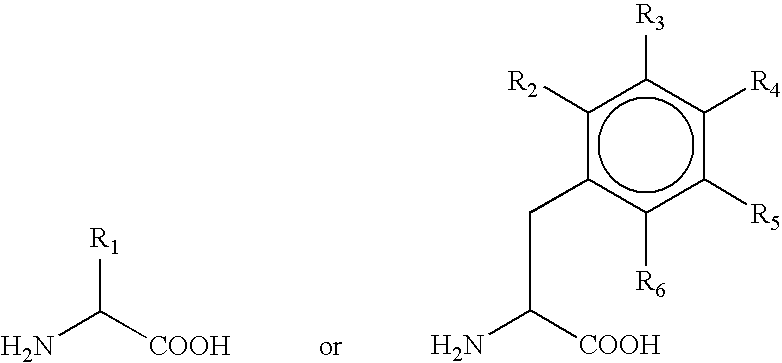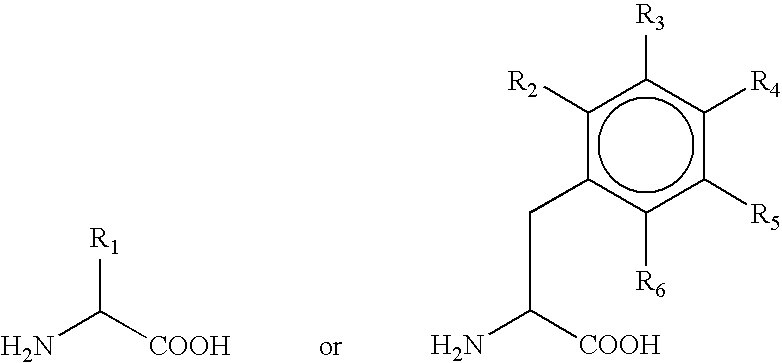Production of alpha-hydroxy-carboxylic acids using a coupled enzyme system
a technology of alpha-hydroxy-carboxylic acid and enzyme system, which is applied in the direction of biochemistry apparatus and processes, microbiological testing/measurement, organic chemistry, etc., can solve the problems of limited general utility, limited yield of d-hydroxy-carboxylic acid derivatives, and expensive starting materials of limited availability
- Summary
- Abstract
- Description
- Claims
- Application Information
AI Technical Summary
Benefits of technology
Problems solved by technology
Method used
Image
Examples
example 1
[0035] L-Amino Acid Oxidase Gene Isolation and Manipulation
[0036] The amino acid deaminase gene from P. myxofaciens was isolated by whole cell PCR using primers (see Table 2) designed to the published P. mirabilis DNA sequence. Ligations were carried out using a Takara Biochemicals DNA ligation kit from Panvera (Madison, Wis.). PCR was carried out using standard conditions in a Perkin Elmer 9600 Thermal Cycler with Taq or Ultma DNA polymerase from Perkin Elmer (Norwalk, Conn.). Oligonucleotides were prepared using an Applied Biosystems 300 B DNA synthesizer.
2TABLE 2 Primers used to construct plasmid pPT381 (aad 6xHis) Pri-mer Sequence 5' 5'-TTT GGA TCC AAA ATG AAC ATC TCT CGT CGT aad AAA CTG CTG TTA GGT GTT GGT GCT GCG GGC GT-3' MB- BamHI 2171 3' 5'-AGC TTT GTC GAG COG CCC TTA GTG ATG GTG aad ATG GTG ATG CTT CTT AAA ACG ATC CAA AC-3' 6x- SalI His MB-2280 Underline designates the aad gene and bold designates the 6xHis insert at the C-terminus.
example 2
[0037] Screening Studies for L-Amino Acid Oxidase
[0038] Oxygen consumption was measured using a Clark-type O.sub.2 electrode in an Oxygraph system from Hansatech Instruments (Norfolk, England), which was zeroed with dithionite. Amino acid substrates (10.0 mM) were incubated in 50 mM potassium phospate buffer, pH 7.5, at 30.degree. C. for 2 minutes in a total volume of 990 .mu.l prior to adding enzyme. Reactions were initiated by adding 10 .mu.l enzyme (104 .mu.g protein) and the O.sub.2 consumption measured for an additional 3 minutes. L-phenylalanine was used as the reference substrate and the linear rate was determined and set to 100%. All other amino acids were compared to L-phenylalanine after a buffer-only blank rate was subtracted.
example 3
[0039] Screening Studies for Lactate Dehydrogenase
[0040] Lactate dehydrogenases were screened on a number of keto acid substrates at 25.degree. C. with a SpectraMax 250 microplate reader from Molecular Devices (Sunnyvale, Calif.). Reactions were carried out by adding 10 .mu.l dilute enzyme to 190 .mu.l of 30 mM keto acid+0.6 mM NADH in 100 mM potassium phosphate buffer, pH 7.0, and monitoring NADH oxidation at 340 nm. Pyruvate was used as the reference substrate and the enzymes' activities were determined and set to 100%. All other keto acids were compared to pyruvate after adjusting for background activity on a buffer-only blank.
PUM
| Property | Measurement | Unit |
|---|---|---|
| pH | aaaaa | aaaaa |
| pH | aaaaa | aaaaa |
| total volume | aaaaa | aaaaa |
Abstract
Description
Claims
Application Information
 Login to View More
Login to View More - R&D
- Intellectual Property
- Life Sciences
- Materials
- Tech Scout
- Unparalleled Data Quality
- Higher Quality Content
- 60% Fewer Hallucinations
Browse by: Latest US Patents, China's latest patents, Technical Efficacy Thesaurus, Application Domain, Technology Topic, Popular Technical Reports.
© 2025 PatSnap. All rights reserved.Legal|Privacy policy|Modern Slavery Act Transparency Statement|Sitemap|About US| Contact US: help@patsnap.com


